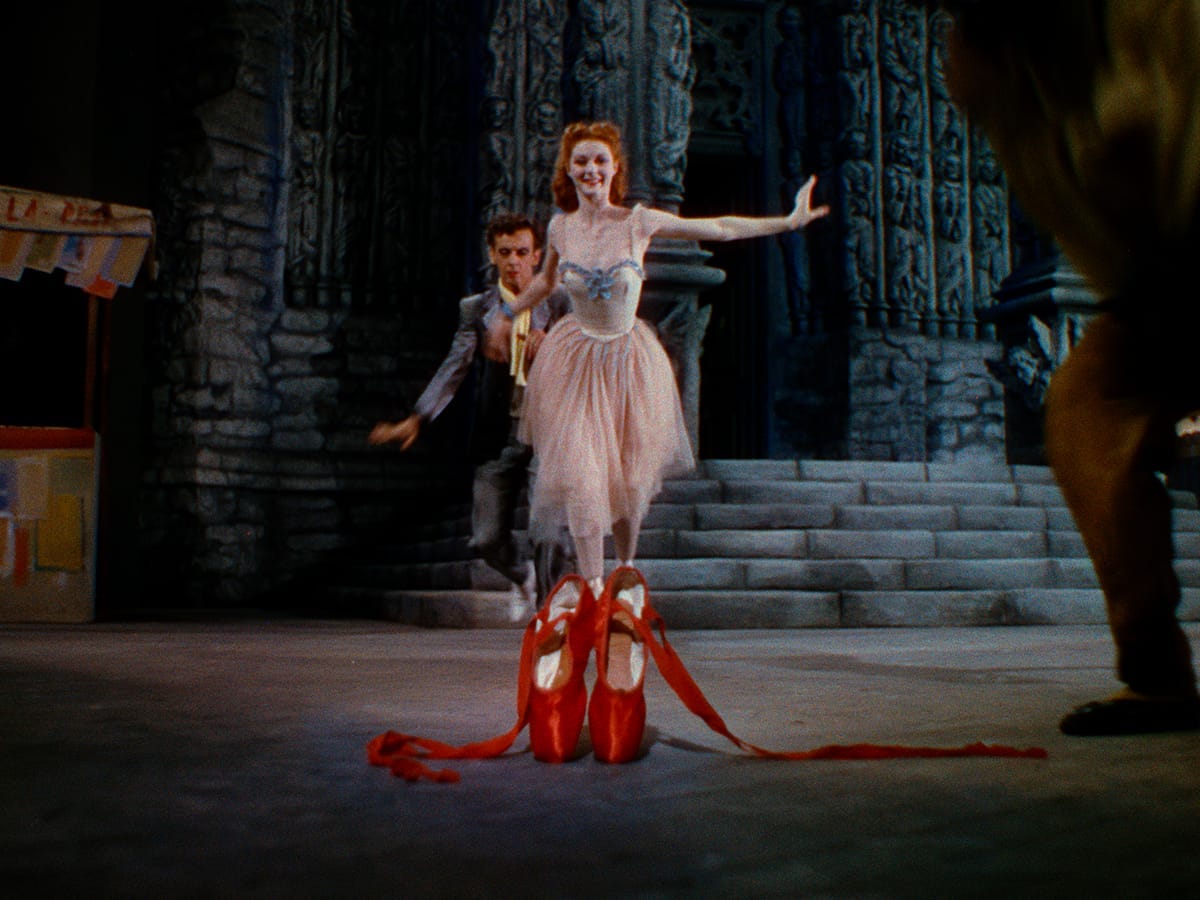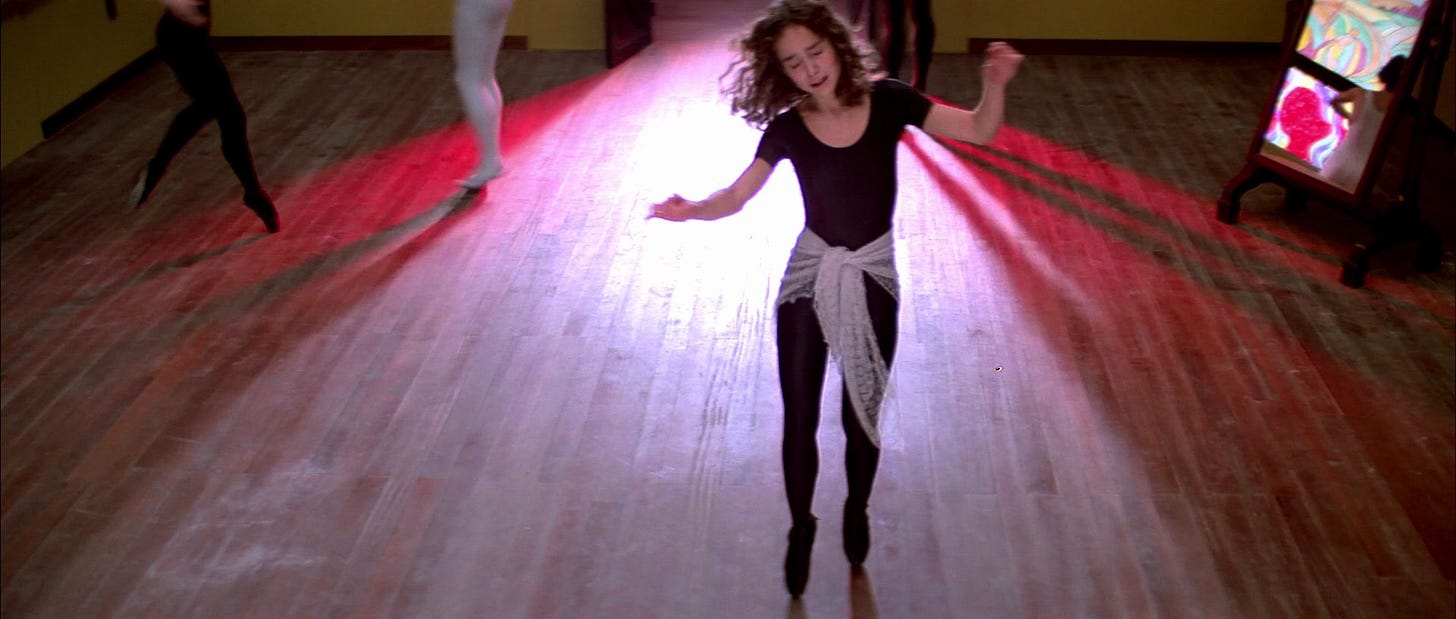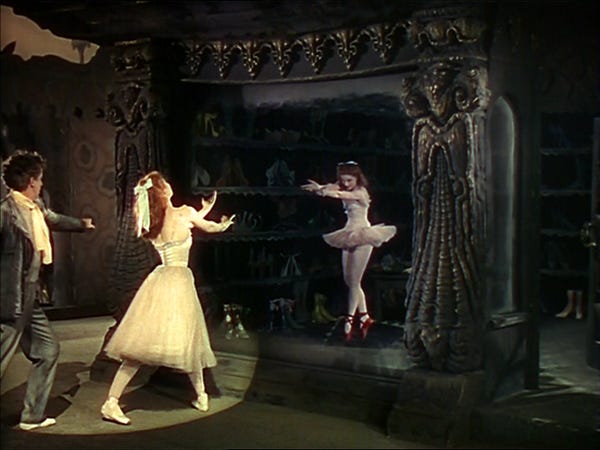Danse Macabre: Orchestrating the Horror of Ballet
Dance horror and its common tropes, written by Georgia Hunter.
Dance horror is an ever-emerging genre which has found its footing more recently with the rampant fever dream of Gasper Noe's Climax (2018) to the cerebrally dark reimagining of a Giallo classic in Luca Guadagnino's Suspiria (2018). While these films differ in the dance they choose to present and how these art forms shape the horror on screen, they share a renewed interest in exploring this niche genre of horror films.
As a device, dance is often used by directors to offset the mood within the horror-thriller genre - whether that be Buffalo Bill dancing in Silence of the Lambs, the iconically disturbing ear removal sequence in Reservoir Dogs, or even perhaps more playfully, the possessed performance of Day-O by unwilling dinner guests in Beetlejuice. However, when used as a driving force within a film's narrative beyond being a backdrop, the film can turn its focus to more compelling ideas of female agency and terror in the face of dangerous threats.
Ballet is the earliest medium of dance explored in horror, and the dance itself is inextricably linked to traditional ideas of femininity. Dario Argento's Suspiria (1977) is often considered a starting point for this dance horror genre, which ProjectOurs will be screening at Fabrica with a Church of Italio afterparty on October 27th (read more here!). It's a personal favourite of mine, and I absolutely adore the balancing act of aesthetic beauty and horror in the film.
To celebrate this immersive Halloween screening, I will discuss a brief history of dance horror, beginning with its origins in film and its influence today in the horror genre. In this post, I will discuss the common themes and tropes dance horror explores - mainly focusing on the most influential films in the genre and touching on other dance horrors where relevant. These largely concern femininity and theses cis women characters' pressures, as most dance and horror films concern themselves with these gendered ideals.
A small disclaimer: while I'm not a dance major, I love dance performances and find the art form mesmerising. It's the perfect cerebral mode of expression, and I adore seeing screen dance or dance on screen. So, I will not dissect the choreography or dances themselves beyond my novice understanding.
Once Upon a Time…: The Origins of Ballet in Dance Horror
Out of the array of different types of dance, ballet has featured most prominently in early examples of the dance horror genre and the more iconic (think Black Swan). Ballet itself is a dance form inextricably linked with class, catering to a historically Western, upper-class and white audience. As expected, these dance recital narratives told through ballet often concern traditional fairy tales - with Swan Lake and The Nutcracker being the most famous examples.
Powell and Pressberger's The Red Shoes (1948) is a cornerstone of horror and dance, especially ballet. The most famous of this directorial duo's work (which is currently receiving a complete retrospective from the BFI in the UK), the plot is loosely based on a 19th-century fairytale of the same name written by Hans Christian Andersen. The original fable acts as a didactic tale in which a girl is forced to dance continually in her red shoes, which takes complete control over her movements whenever she acts with vanity. Like most fairy tales, this has a somewhat grim conclusion of her feet being amputated due to her being unable to stop, yet these removed limbs continue to dance around town. While the film itself is a loose adaptation of this fable, using it for the narrative of Victoria, the ballet dancer’s show, it does have a verbatim dance sequence depicting the fairytale as a ballet performance. Likewise, this story ends up bleeding into the rest of Victoria's life in similarly moralising and tragic ways.
While The Red Shoes is not a horror film, this narrative exploration of dance acts as a blueprint for it later as a horror device. There are still tragic and horror-inflicted moments in the psychological drama within its 17-minute uninterrupted ballet sequence performance of the red shoes tale. This scene follows Victoria's performance on stage as, in an impressionistic fashion, the reality of the performance and the fantasy of the fairytale begin to blur.
While Dario Argento's Suspiria (1977) is one of the most famous horror films featuring dance, this film uses dance as the backdrop for its action. It is not an art form integral to the film; in fact, it feels almost incidental in its lack of influence over the narrative. Besides having an iconic building housing the plot and being influential in generating a fantastical location and backdrop for witches, being a dance school serves little else to the plot. However, the film builds upon tropes from The Red Shoes and is still impactful in dance horror today.
It's also worth noting that many of these tropes intersect and build off each other, as you'll see in my discussion points below.
Mythmaking: Fantasy or Reality?
"[F]airy stories are a reflection of our fears and desires; almost a dream-like state within fantasy." - Carol J. Clover’s Her Body, Himself: Gender in the Slasher Film (1983)
The first trope established in dance horror is the necessity of a fairytale or some fantastical element that intersects with the reality of the situation. This merger of reality with fiction is embellished with dance horror as it tip-toes the line between psychologically and superstitiously horrifying.
The Red Shoes is a story grounded in reality loosely based on the Hans Christian Andersen fairytale. However, this fable spills over into Victoria Page's real life. Beyond the plot, if we are to focus on The Red Shoes' fantastical ballet performance, we see the bright and colourful ways in which horror and ballet coincide. The impressionistic scenes and the moralistic edge from the Andersen tales are transplanted into the film's wider narrative, having art imitate life in its tragic finale.
Enforcing dance as a trope, Dario Argento also embraces a fairytale-like quality to the horror in Suspiria. Suzy Bannion is whisked away in the dead of night to a dance school, which will become her place of study and home for the remainder of her time there. Although Suzy is an adult entering adult education, she is kept in a gender-segregated boarding school setup wherein her peers are prone to the pettiness and immaturity you'd associate with teenagers in high school. For example, there is one scene in which the characters’ bickering escalates into a hissing competition in the changing rooms as they call each other snakes.
These women are made juvenile and youthful under the confines of a regimented educational institute with strict schedules administered by uptight teachers. From set meal times, to having to solve mysteries after curfew by counting footsteps while in bed, to having a sleepover in a hall - the drama is high stakes within a seemingly innocent background. This isn't by mistake. In setting the horror within the precinct of a dance school and with the mysticism of witchcraft and wolf-men as a backdrop, Argento creates an atmosphere evocative of the scary stories that would keep our younger selves awake at night. The strict school rules wholeheartedly inform these young adults of becoming believably involved in a youthful, fairytale set-up.
This can even be found beyond the film's themes and plot. Suspiria was shot on three different technicolour reels, then combined, giving the bulb-bright intensity of colour for which the film became iconic. This is not dissimilar to The Red Shoes, which used a similar technique to bind together three types of colour film, giving an ethereal wash of technicolour to the film's palette. The two films share these picturesque tones and colour gradings, which help mythicise the action on screen.
Cathartic Chaos: Cognitive Dissonance and a Loss of Control
“Participants in dance, both dancers and viewers, may experience catharsis and develop a sense of mastery or self-discovery.” – Judith Lynne Hanna’s Dance and Stress: Resistance, Reduction, and Euphoria (1998)
Another trope that often builds upon the previous trope of fantasy fraying the seams of reality apart is a character's developing cognitive dissonance and descent into mental instability. Like any art medium, dance is a tool for expressing what the characters cannot say. With dance horror, there is a tendency for narratives to focus on the characters' own darker inner turmoils, overspilling into their practices. This is only heightened when fantasy and reality are inseparable.
Dance itself is a very demanding sport and art form with a problematic track record. Ballet, in particular, has unprecedented expectations required of its performers. As with mastering any skill, ballet takes tremendous discipline, routine, and time to hone and become excellent at.
However, it is often in dance horrors that the performance they are working towards perfecting, and thus being in complete control of, begins to inverse on them. In a beautiful metaphor, the source of their ambitious obsession - their craft - inverses the power-control relationship wherein dance as a medium is controlling them. This destructive obsession further carries the theme of reality and fantasy blurring, as it is often due to the psychological turmoil suffered by these characters that result in their loss of control.
Most dance horrors concern dancers. These are dance students, teachers, professionals, and performers. In Gasper Noe's downward spiral in Climax (2018), it's a dance troupe. Black Swan (2010) and The Red Shoes (1948) both feature ballet leads pressured by their demanding, obsessive teacher. In both Suspirias (1977 and 2018), it’s academy students at rigid schools. It is natural, then, that the dancers’ artistic ambitions and their real lives intersect into a blurry mirage of art imitating life imitating art. The Red Shoes' ballet performance acts as a very Jungian (or arguably Freudian) window or dream narrative into Victoria's inner psyche as she is torn between two loves of her life. This dichotomy of dual desires creates a cognitive dissonance in the character, who ultimately collapses under the pressure into chaos and a loss of control and identity. Without grounding, the dancer doesn't know who or what they are other than dance. Ultimately, this epitomises a quote supposedly inspired by Hunter S. Thompson: "Are we human or are we dancers?"
Sometimes, these psychological collapses aren't always within the realm of reality to minimise. Sometimes, these characters' lives fall out of control because they are puppets and conduits to something much greater than themselves, like occults far too powerful to resist.
It is pretty self-evident in The Red Shoes as this loss of control over oneself and one's craft is inherent in the myth. This dance performance begins to bleed into the reality of Victoria’s life, which slowly unravels around her, with the film's tragic end having an ambiguity to fact or fiction.
While Argento's Suspiria is a film famous for its dance school backdrop, hardly any dance is featured in the film. The one scene in which a dance class takes place is on Suzy's second day in the academy. Asked to dance around the room to rehearse their steps, a woozy Suzy staggers breathlessly from wall to wall, struggling to complete her routine despite the demands of the strict ballet teacher. It is almost like she is completely powerless, dancing without agency in almost a ragdoll manner. This gives the effect of a lack of control as she is almost strung around wall to wall under the whims of her ballet teacher, who we can only infer is the reason why her life source is being drained.
This theme of control has become an emblematic trope of dance horror today, and it is continually used within dance-related films. This theme of dance becoming a tool of control is explored further in the 2018 reimagining of Luca Guadagnino's Suspiria. In the new Suspiria, it's inverted, where the witches use dance as a form of magical "voodoo." The witches can turn their dance movements to disfigure the bodies of other dance students.
Ultimately, I think Argento's Suspiria is the better film (with a better score). Yet, Guadagnino's Suspiria has impressive creativity in its use of dance within the film and historical grounding with its world-building. Unlike the fairytale and mythmaking found in the elusive German town presented in the original, the Berlin Wall and its counter-protest violence are at the beating heart of Guadagnino's Suspiria. And it is telling in a way that the move away from tradition leads to a move away from fairytales.
Rather than the implied loss of control from dance in Argento’s slightly shallow exploration of the art form, Guadagino's Suspria turns Suzy's puppet on strings into something far more explicit in the grotesque mishappenings of bodies. Dance becomes a weapon and ritual practice.
Interestingly, both 2018 features, Climax and Suspiria, share a similar final dance sequence that bookends their films. In both films, red bathes the screen in these scenes, whether with floods of colour or literal bloodbaths. The camera movement manoeuvres in personal and cerebral ways. In Climax specifically, the camera flips upside down in a demonic demonstration of entering a mental space of literal hell wherein the perspective is entirely inverted.
Doppelgänger Duets: Duplicity and Duality
“The doppelgänger is a monster that is not apart from us. It’s a monster that is a part of us.” - Adam Golub’s America’s Shadow: A Cultural History of the Doppelgänger (2022)
A final core trope of the dance horror genre is one of duality and duplicity found in its characters. Ultimately, as a result of the cognitive dissonance experienced by a character entering the world of fantasy, the character can literally divide into two persons - and so is born a doppelgänger.
While this is very much a common trait in dance horror, this is not a trope instigated by Argento's Suspiria it is in The Red Shoes. During the dance sequence, her desires are reflected to her in a storefront by a body double. This body-double trope certainly builds off of tropes already core to dance horror: the use of fairy tales, the mix of fantasy with fiction, and the physical rupture of the mind under stress.
The first explicit example of this can be seen in Peter Del Monte's Etoile (1989), another Italian horror film mostly lost to obscurity until Black Swan (2010) was released. Black Swan and Etoile share a somewhat similar narrative in exploring identity divisions through the fairytale ballet performance of Swan Lake - with Black Swan being far more influential of the two on genre-defining dance horror.
As previously mentioned, ballet is an intensive physical and artistic skill which is highly demanding for a high-class audience. The dancers must be in full control and have incredible prowess to deliver these perfect results. Yet, that doesn't necessitate that they are able to meet those standards. The body is only human. Often, these dancer characters struggle with this pressure or literally divide into two due to the inner turmoil they experience under such high stakes and demanding settings. It often places a threat on the character's own personal lives by having a distortion of the self become your worst enemy, following a Grimm fairytale logic in its conclusion.
While Etoile certainly influenced Black Swan (2010), animated psychological horror Satoshi Kon's Perfect Blue (1990) is far more of a direct influence. Following a pop idol who dresses like a ballet dancer rather than an actual ballet dancer, and who even moves around like one in the film's finale, the film explores the breakdown of reality when faced with cognitive dissonance in Mima’s career desires and personas. It should come as no surprise that this animation would become highly influential for Black Swan, which meditates on the same themes of duplicity in identity under a ballet guise. (In a complete aside - Princess Tutu is another excellent anime that explores the Swan Lake myth and The Red Shoes myth within a thriller-inflicted narrative).
Jordan Peele's Us (2019) also briefly explores ballet and duplicity more as a narrative tool since it proves to be a doppelgänger-focused horror rather than a dance-focused horror. Integral to the final fight sequence, a pas de deux is implemented to comment on certain power structures in the film's namesake home country. This use of ballet also informs the stunning original score, which I adore.
To Conclude
While the tropes discussed today give a general idea of the horror-dance genre's defining features, this is not the be-all or end-all of discussions explored in dance horror as a whole. My major focus today was ballet in horror, whereas films like Climax (which explores voguing to street dance to B-boying) and Suspiria (2018) (which explores contemporary choreography informed by Martha Graham) have many more conversations to offer in dance horror - including the sensuality of dance, and how it can encourage sexual freedom and celebrate queerness. However, the traits discussed today certainly act as a blueprint found in the genre.










